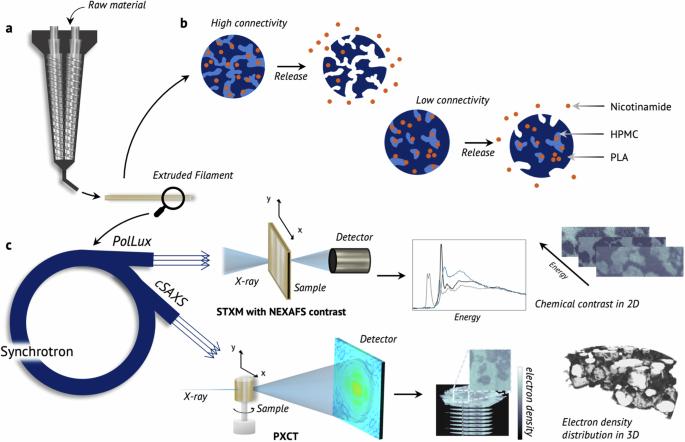相分离聚合物共混物通过调整形态实现可控给药
IF 9.6
Q1 MATERIALS SCIENCE, MULTIDISCIPLINARY
引用次数: 0
摘要
控制药物释放速度并为活性药物成分提供物理和化学稳定性是口服固体制剂的关键特性。在这里,我们展示了一种使用相分离聚合物混合物的配方策略,其形态为调整药物释放曲线提供了一条途径。通过利用疏水性聚合物和亲水性聚合物的相分离,亲水性成分将起到导流作用,在溶解时形成多孔网络,从而决定药物的释放特性。通过 X 射线层析成像和扫描透射 X 射线显微镜,我们揭示了形态如何取决于聚合物成分和药物的存在,以及药物如何分布在聚合物畴上。将 X 射线成像结果与溶解研究相结合,可以揭示形态如何与药物释放相关联,并展示如何利用调整口服制剂中聚合物基质的形态来控制药物释放。通过口服固体制剂给药需要控制释放率以及制剂中药物的物理和化学稳定性。在这里,X 射线断层扫描和光谱分析揭示了相分离聚合物混合物的形态是如何控制药物释放的。本文章由计算机程序翻译,如有差异,请以英文原文为准。

Phase-separated polymer blends for controlled drug delivery by tuning morphology
Controlling drug release rate and providing physical and chemical stability to the active pharmaceutical ingredient are key properties of oral solid dosage forms. Here, we demonstrate a formulation strategy using phase-separated polymer blends where the morphology provides a route for tuning the drug release profile. By utilising phase separation of a hydrophobic and a hydrophilic polymer, the hydrophilic component will act as a channelling agent, creating a porous network upon dissolution that will dictate the release characteristics. With ptychographic X-ray tomography and scanning transmission X-ray microscopy we reveal how the morphology depends on both polymer fraction and presence of drug, and how the drug is distributed over the polymer domains. Combining X-ray imaging results with dissolution studies reveal how the morphologies are correlated with the drug release and showcase how tuning the morphology of a polymer matrix in oral formulations can be utilised as a method for controlled drug release. Drug delivery via solid oral dosage requires a controlled release rate and physical and chemical stability of the drug within the formulation. Here, X-ray tomography and spectromicroscopy reveal how the morphology of a phase-separated polymer blend controls drug release.
求助全文
通过发布文献求助,成功后即可免费获取论文全文。
去求助
来源期刊

Communications Materials
MATERIALS SCIENCE, MULTIDISCIPLINARY-
CiteScore
12.10
自引率
1.30%
发文量
85
审稿时长
17 weeks
期刊介绍:
Communications Materials, a selective open access journal within Nature Portfolio, is dedicated to publishing top-tier research, reviews, and commentary across all facets of materials science. The journal showcases significant advancements in specialized research areas, encompassing both fundamental and applied studies. Serving as an open access option for materials sciences, Communications Materials applies less stringent criteria for impact and significance compared to Nature-branded journals, including Nature Communications.
 求助内容:
求助内容: 应助结果提醒方式:
应助结果提醒方式:


